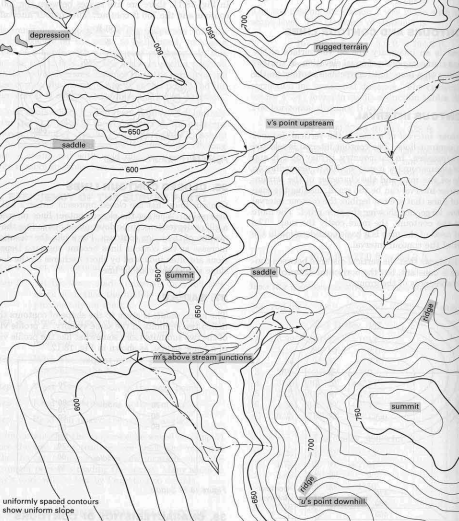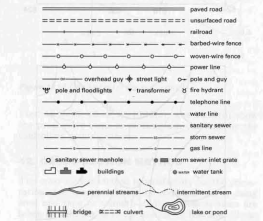- Relief representation;
- Contour interpolation;
- Use and handling of drawing instruments; freehand lettering and drawing;
Lecture 6: Topographic Surveying & Mapping
Geographic Information System
J Mwaura
Lecture Outcomes
Cartography
Cartography is the art & science of making maps
Topographic maps provide a plan view of a portion of the earth's surface showing natural & physical features such as rivers, lakes, roads, buildings, etc.
In topographic mapping, the shape or relief, of the area is shown by contour lines, hachures, or shading
Uses of Topographic Maps
Topographic/Contour maps is the start-point of all planning before construction
Good knowledge of topography should precede the planning of highways, subdivisions, shopping centers, airports, golf courses, and other improvements
Topographic surveys are done to determine the relative positions of points & objects so that the cartographer can accurately represent their positions on the map
Topographic Maps
Types
- Strip map - for narrow in width, long in length projects such as; highways, railroads, pipelines, powerlines etc.
- Area map - for localized projects such as; development of subdivisions, shopping centers, airports etc.
Contour & Contour Lines
A contour is an imaginary line on the earth's surface that connects points of equal elevation
A contour line is a line on a map that represents a contour on the ground
In a topographic map, every 5th contour line - "index contour" may be darker and the elevation of that contour line is written in a break in the line

Contour Interval
Contour interval of a map, is a vertical distance between contour lines
Choice of interval depends on character of terrain, purpose & scale of map e.g. in flat county - 0.5m, in mountainous county - 50m
The more accurate the contours, the more costly the map
Contour Line

Contour lines that are closed represent either a hill or depression
- For a hill, the
elevations increaseas the contour lines become shorter - Depressions are often indicated by
short hachureson the down slope side of the contour line
Saddle
A saddle is given to the shape of contours that define two summits in the same vicinity


Characteristics of Contours
- Each contour line must close upon itself either within or outside the borders of the map
- Contour lines cannot cross or meet, except in unusual cases of waterfalls or cliff overhangs
- A series of closed contour lines represents either a hill or depression
- Contour lines crossing a stream form
V'sthat point upstream - Contour lines crossing a ridge form
U'sthat point down the ridge - Contour lines tend to parallel streams
- Contour lines form
M'sjust above stream junctions - Contour lines are uniformly spaced on uniformly sloping ground
- Irregularly spaced contour lines represent rough, rugged ground
- Horizontal distance between contour lines indicates the
slopeof the ground - Contours are perpendicular to the direction of maximum slope
Contouring Methods
Several methods of locating contours are used in topographic surveying and mapping
- Coordinate method
- Grid method
- Controlling points method
- Cross-section method
- Tracing contours method
All methods except coordinate method depend on the assumption that there is a uniform slope between any two ground points located in the field
Mapping
First step of preparing a map
- Selection of a scale & a contour interval
- This selection is influenced by
- The size of paper
- The purpose of the map
- The required accuracy
Assignment: Plot contours by grid method, tracing method, coordinate method by hand & computer
Typical Map Symbols in Topographic Maps

End of Lecture
Geographic Information System
That's it!
Queries about this Lesson, please send them to:
*References*
- Geographic Information System Basics, 2012
J.E.Campbell & M. Shin- Fundamentals of GIS, 2017
Girmay Kindaya- GIS Applications for Water, Wastewater, and Stormwater Systems, 2005
U.M. Shamsi- Analytical and Computer Cartography, 2nd ed.
Keith C. Claike- Geographic Information Systems: The Microcomputer and Modern Cartography, 1st ed.
Fraser Taylor- Land_Surveyor_Reference_Manual, 2nd ed.
Andrew_L._Harbin
Courtesy of Open School